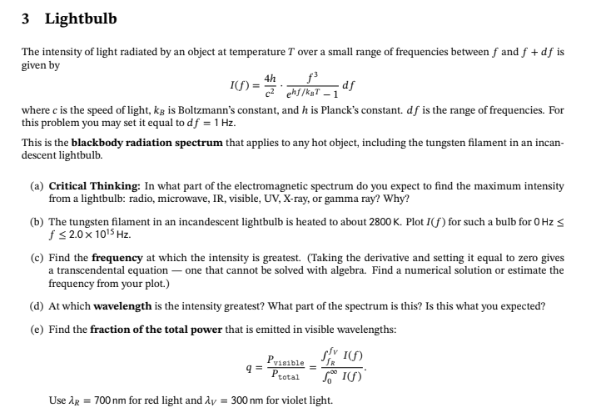3 Lightbulb The intensity of light radiated by an object at temperature T over a small range of frequencies between f and f + df is given by 4h where c is the speed of light, kg is Boltzmann's constant, and h is Planck's constant. df is the range of frequencies. For this problem you may set it equal to df = 1 Hz. This is the blackbody radiation spectrum that applies to any hot object, including the tungsten filament in an incan- descent lightbulb. (a) Critical Thinking: In what part of the electromagnetic spectrum đo you expect to find the maximum intensity from a lightbulb: radio, microwave, IR, visible, UV, X-ray, or gamma ray? Why? (b) The tungsten filament in an incandescent lightbulb is heated to about 2800 K. Plot I(f) for such a bulb for OHz S f $20x 1015 Hz.
3 Lightbulb The intensity of light radiated by an object at temperature T over a small range of frequencies between f and f + df is given by 4h where c is the speed of light, kg is Boltzmann's constant, and h is Planck's constant. df is the range of frequencies. For this problem you may set it equal to df = 1 Hz. This is the blackbody radiation spectrum that applies to any hot object, including the tungsten filament in an incan- descent lightbulb. (a) Critical Thinking: In what part of the electromagnetic spectrum đo you expect to find the maximum intensity from a lightbulb: radio, microwave, IR, visible, UV, X-ray, or gamma ray? Why? (b) The tungsten filament in an incandescent lightbulb is heated to about 2800 K. Plot I(f) for such a bulb for OHz S f $20x 1015 Hz.
Related questions
Question
Please solve A-C

Transcribed Image Text:3 Lightbulb
The intensity of light radiated by an object at temperature T over a small range of frequencies between f and f + df is
given by
4h
I) = -1
Sp-
where c is the speed of light, kg is Boltzmann's constant, and h is Planck's constant. dƒ is the range of frequencies. For
this problem you may set it equal to df = 1 Hz.
This is the blackbody radiation spectrum that applies to any hot object, including the tungsten filament in an incan-
descent lightbulb.
(a) Critical Thinking: In what part of the electromagnetic spectrum do you expect to find the maximum intensity
from a lightbulb: radio, microwave, IR, visible, UV, X-ray, or gamma ray? Why?
(b) The tungsten filament in an incandescent lightbulb is heated to about 2800 K. Plot I(f) for such a bulb for O Hz S
f 32.0x 1015 Hz.
(c) Find the frequency at which the intensity is greatest. (Taking the derivative and setting it equal to zero gives
a transcendental equation – one that cannot be solved with algebra. Find a numerical solution or estimate the
frequency from your plot.)
(d) At which wavelength is the intensity greatest? What part of the spectrum is this? Is this what you expected?
(e) Find the fraction of the total power that is emitted in visible wavelengths:
Prisible
Protal
Use AR = 700 nm for red light and Ay = 300 nm for violet light.
Expert Solution
This question has been solved!
Explore an expertly crafted, step-by-step solution for a thorough understanding of key concepts.
Step by step
Solved in 4 steps with 2 images
